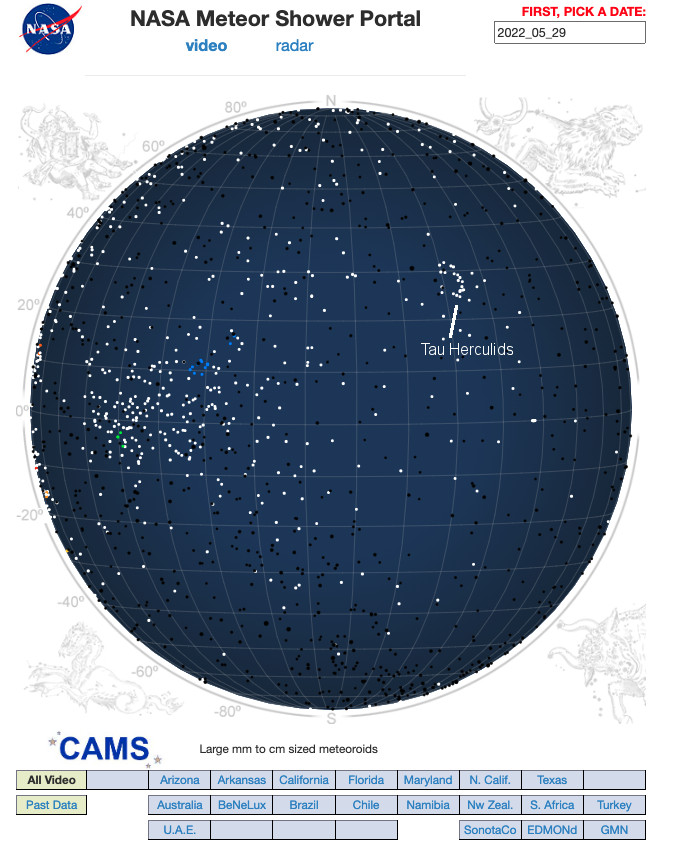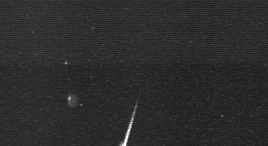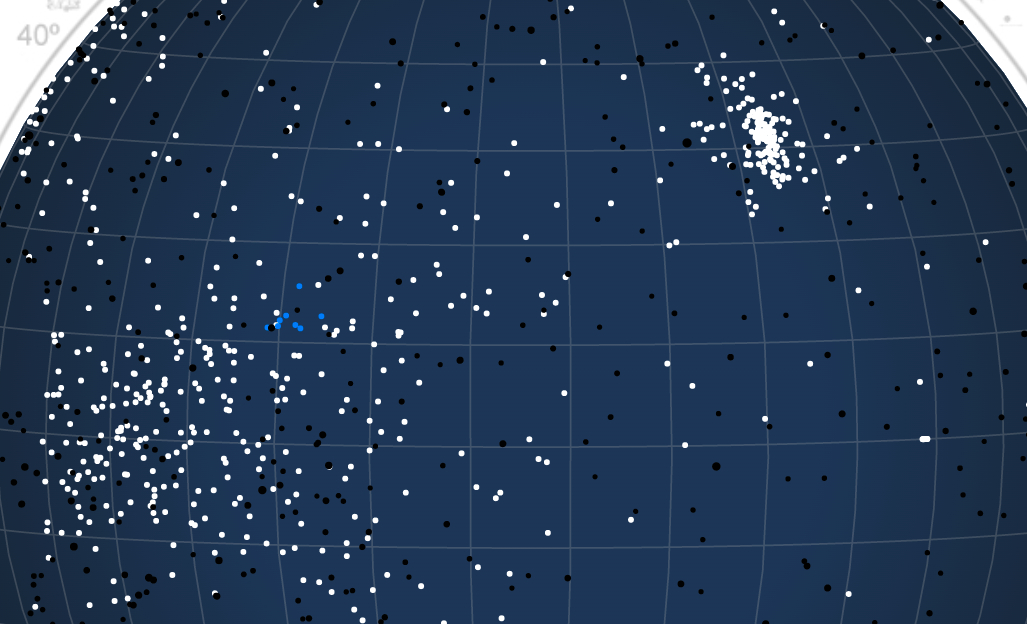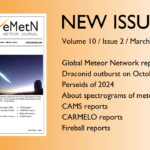Abstract: The Cameras for Allsky Meteor Surveillance (CAMS) project, which triangulates video-detected meteors visible to the naked eye, has detected the first 2022 tau Herculids (TAH #0061) starting on May 27. This is still days prior to an anticipated outburst of tau Herculids on 2022 May 31 from Earth’s crossing of debris generated during the 1995 breakup of comet 73P/Schwassmann-Wachmann. On May 31 (evening May 30 for US observers), that outburst is expected to peak either around 03:52 UT or around 05:01 UT, and last about 2 hours. The shower will be rich in faint meteors, and observers are recommended to search for a dark observing site that fully benefits from the new Moon conditions.
Introduction
A meteor outburst of tau Herculid meteors (IAU shower 61) is anticipated for May 31 around 4h-5h UT this year. This outburst is unusual in that the debris was generated during the 1995 breakup of comet 73P/Schwassmann-Wachmann (Luethen et al. 2001). Independent calculations at I.M.C.C.E. and the University of Maryland, using slightly different inputs, put the 1995 dust trail in the Earth’s path with an expected peak on May 31 05:01 and 03:52 UT, respectively (Ye et al., 2022, Jenniskens et al., 2022). In both models, meteors will radiate from R.A. = 209 deg, Decl. = +28 degrees with an apparent velocity of 16.4 km/s (geocentric velocity 12.1 km/s), North-West of the star Arcturus in the constellation Bootes. The outburst is expected to last about two hours. Observers in the continental USA and Mexico are most favorably located to see this event in new-moon conditions, with a radiant high in the northwest, in the evening of May 30 local time.
Calculations at the University of Maryland show that when the Earth crosses the meteoroid stream, a very faint glow from scattered sunlight may be visible in the sky centered around R.A. = 170 deg, Decl. = +20 deg in Leo, and around R.A. = 355 deg, Decl. = -15 deg in the opposite direction in Equuleus.
Finally, two dust trails from the normal 1892 and 1897 returns of 73P will also be in the earth’s path around 16h UT on May 30 and 10h UT on May 31, respectively (Wiegert et al. 2005). Because the comet has been known only since 1930, these trail crossings could shed new light onto the past activity of the comet, if detected.

Figure 1. Near-real time display of CAMS data for May 29, 2022. Tau Herculids are marked. The site is at: http://cams.seti.org/FDL/ (choose a date to bring up that night’s observations).
First observations
Here, we report that the Cameras for Allsky Meteor Surveillance (CAMS) project now has detected the first 2022 tau Herculids (TAH #0061) starting on May 27 (UT). That day, five tau Herculids were detected by CAMS Texas, LO-CAMS (Arizona), CAMS Namibia and CAMS BeNeLux. The meteors radiated from a geocentric radiant at R.A. = 205.6 ± 2.0, Decl. = 24.1 ± 5.0 with Vg = 10.2 ± 0.8 km/s.
The next day, May 28, 7 tau Herculids were triangulated by CAMS Namibia, CAMS Arkansas and LO-CAMS. The meteors radiated from a geocentric radiant at R.A. = 203.3 ± 2.1, Decl. = 17.3 ± 2.5 with Vg = 10.8 ± 1.4 km/s.
And on May 29, 12 tau Herculids were triangulated by CAMS Namibia, CAMS Chile, CAMS Arkansas, LO-CAMS and CAMS California. The meteors radiated from a geocentric radiant at R.A. = 203.5 ± 1.7, Decl. = 20.2 ± 2.0 with Vg = 11.1 ± 0.9 km/s.
All detected tau Herculids so far had a magnitude distribution from -3 up: 1, 1, 0, 2, 4, 13, 8, 3. Some of these were bright enough to be photographed, but overall the distribution implies a shower rich in faint meteors.
 Figure 2. A tau-Herculid detected by camera 909 of LO-CAMS (Nick Moskovitz) at 06:02:28 UT on May 29, 2022.
Figure 2. A tau-Herculid detected by camera 909 of LO-CAMS (Nick Moskovitz) at 06:02:28 UT on May 29, 2022.
In prior years, only 18 tau Herculids were detected during the dust-trail crossings in 2011, 2017/ and 2019. Those dust trails came from normal comet activity. These 18 meteors imply a steep magnitude-distribution index of 5.4 +/- 1.1, meaning that there were five times more meteors of magnitude +4 than +3, five times more meteors of mag +3 than +2, etc. — but with the camera sensitivity such that more meteors of magnitude +3 were detected. In practice, a few meteors were magnitude +1, but most were near the +4 magnitude detection limit of the video cameras.
What to expect for 1995-debris encounter?
There is already an unusual meteor shower in the sky at the moment. The early sighting of tau Herculids bodes well for some further enhancement of rates, but it is unclear at present whether the current activity relates to the 1995 breakup or, perhaps more likely, dates from prior returns.
Model calculations (e.g., Ye et al., 2022) suggest that whether or not the rates will significantly increase on May 31 UT depends on the meteoroid ejection velocities during the breakup and decay of fragments. They need to be a factor of 2.5 higher than under normal cometary ejection conditions. Because the comet itself is not near the Earth, normal ejection does not have the meteoroids disperse far enough ahead of the comet to intersect the earth’s path. The higher gas-production rate of comet 73P in 1995 suggests that ejection velocities may have been higher by up to a factor of 2.7. However, the ejection velocities of cm- and mm-sized meteoroids were not measured in 1995.
References
Jenniskens P., Ye Q., Vaubaillon J. (2022). “Tau Herculid meteor shower 2022”. CBET 5125. Ed.: D.W.E. Green, Cambridge: CBAT. Issued May 26, 2022.
Lüthen H., Arlt R., and Jäger M. (2001). “The disintegrating comet 73P/Schwassmann-Wachmann 3 and its meteors”. WGN, Journal of the International Meteor Organization, 29, 15-28.
Wiegert P. A., Brown P. G., Vaubaillon J., and Schijns H. (2005). “The τ Herculid meteor shower and Comet 73P/Schwassmann-Wachmann 3”. Monthly Notices of the Royal Astronomical Society, 361, 638-644.
Ye Q., Vaubaillon J., Desmars J. (2022) “The 2022 Encounter of the outburst material from comet 73P?Schwassmann-Wachmann 3. MNRAS (submitted).



